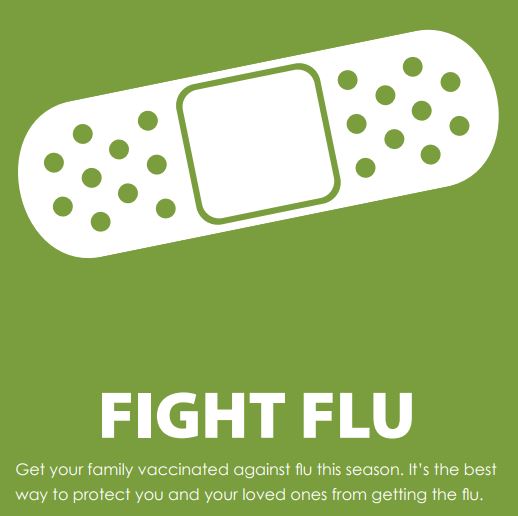
Influenza
What is Influenza (also called Flu)?
The flu is a contagious respiratory illness caused by influenza viruses that infect the nose, throat, and sometimes the lungs. It can cause mild to severe illness, and at times can lead to death. The best way to prevent the flu is by getting a flu shot each year.
Flu Symptoms & Complications
Signs and Symptoms of Flu
- People who have the flu often feel some or all of these signs and symptoms that usually start suddenly, not gradually:
- Fever* or feeling feverish/chills
- Cough
- Sore throat
- Runny or stuffy nose
- Muscle or body aches
- Headaches
- Fatigue (very tired)
- Some people may have vomiting and diarrhea, though this is more common in young children than in adults.
*It’s important to note that not everyone with flu will have a fever.
Flu Complications
Most people who get influenza will recover in several days to less than two weeks, but some people will develop complications as a result of the flu. A wide range of complications can be caused by influenza virus infection of the upper respiratory tract (nasal passages, throat) and lower respiratory tract (lungs). While anyone can get sick with flu and become severely ill, some people are more likely to experience severe flu illness. Young children, adults aged 65 years and older, pregnant women, and people with certain chronic medical conditions are among those groups of people who are at high risk of serious flu complications, possibly requiring hospitalization and sometimes resulting in death. For example, people with chronic lung disease are at higher risk of developing severe pneumonia.
Sinus and ear infections are examples of moderate complications from flu, while pneumonia is a serious flu complication that can result from either influenza virus infection alone or from co-infection of flu virus and bacteria. Other possible serious complications triggered by flu can include inflammation of the heart (myocarditis), brain (encephalitis) or muscle (myositis, rhabdomyolysis) tissues, and multi-organ failure (for example, respiratory and kidney failure). Flu virus infection of the respiratory tract can trigger an extreme inflammatory response in the body and can lead to sepsis, the body’s life-threatening response to infection. Flu also can make chronic medical problems worse. For example, people with asthma may experience asthma attacks while they have the flu, and people with chronic heart disease may experience a worsening of this condition triggered by flu.
When is the flu season in the United States?
In the United States, flu season occurs in the fall and winter. While influenza viruses circulate year-round, most of the time flu activity peaks between December and February, but activity can last as late as May.
How many people get sick or die from the flu every year?
Flu seasons vary in severity depending on a number of factors including the characteristics of circulating viruses, the timing of the season, how well the vaccine is protecting against influenza infection, and how many people got vaccinated. While the impact of influenza varies from season to season, it places a substantial burden on the health of people in the United States: millions of people become ill, hundreds of thousands are hospitalized and thousands or tens of thousands of people die from flu every year.
How Flu Spreads
Person to Person
People with flu can spread it to others up to about 6 feet away. Most experts think that flu viruses are spread mainly by droplets made when people with flu cough, sneeze or talk. These droplets can land in the mouths or noses of people who are nearby or possibly be inhaled into the lungs. Less often, a person might also get flu by touching a surface or object that has flu virus on it and then touching their own mouth or nose.
To avoid this, people should stay away from sick people and stay home if sick. It also is important to wash hands often with soap and water for at least 20 seconds. If soap and water are not available, use an alcohol-based hand rub. Linens, eating utensils, and dishes belonging to those who are sick should not be shared without washing thoroughly first. Eating utensils can be washed either in a dishwasher or by hand with water and soap and do not need to be cleaned separately. Further, frequently touched surfaces should be cleaned and disinfected at home, work and school, especially if someone is ill.
Period of Contagiousness
Most healthy adults may be able to infect other people beginning 1 day before symptoms develop and up to 5 to 7 days after becoming sick. Children may pass the virus for longer than 7 days. Symptoms start 1 to 4 days after the virus enters the body. That means that you may be able to pass on the flu to someone else before you know you are sick, as well as while you are sick. Some people can be infected with the flu virus but have no symptoms. During this time, those persons may still spread the virus to others.
People at High Risk for Developing Flu-Related Complications
People at High Risk for Developing Flu-Related Complications
- Children younger than 5, but especially children younger than 2 years old
- Adults 65 years of age and older
- Pregnant women (and women up to two weeks postpartum)
- Residents of nursing homes and other long-term care facilities
- Also, American Indians and Alaskan Natives seem to be at higher risk of flu complications
People who have medical conditions including
- Asthma
- Neurological and neurodevelopmental conditions [including disorders of the brain, spinal cord, peripheral nerve, and muscle such as cerebral palsy, epilepsy (seizure disorders), stroke, intellectual disability (mental retardation), moderate to severe developmental delay, muscular dystrophy, or spinal cord injury].
- Chronic lung disease (such as chronic obstructive pulmonary disease [COPD] and cystic fibrosis)
- Heart disease (such as congenital heart disease, congestive heart failure and coronary artery disease)
- Blood disorders (such as sickle cell disease)
- Endocrine disorders (such as diabetes mellitus)
- Kidney disorders
- Liver disorders
- Metabolic disorders (such as inherited metabolic disorders and mitochondrial disorders)
- Weakened immune system due to disease or medication (such as people with HIV or AIDS, or cancer, or those on chronic steroids)
- People younger than 19 years of age who are receiving long-term aspirin therapy
- People with extreme obesity (body mass index [BMI] of 40 or more)
There is no recommendation for pregnant women or people with pre-existing medical conditions to get special permission or written consent from their doctor or health care professional for influenza vaccination if they get vaccinated at a worksite clinic, pharmacy or other location outside of their physician’s office. For more information, visit Misconceptions about Seasonal Flu and Flu Vaccines.
Preventive Actions
Influenza (flu) is a contagious disease that can be serious. Every year, millions of people get sick, hundreds of thousands are hospitalized, and thousands to tens of thousands of people die from flu. CDC urges you to take the following actions to protect yourself and others from flu.
Get yourself and your family vaccinated.
- CDC recommends a yearly flu vaccine as the first and most important step in protecting against flu viruses.
- While there are many different flu viruses, a flu vaccine protects against the viruses that research suggests will be most common. (See Vaccine Virus Selection for this season’s vaccine composition.)
- Flu vaccination can reduce flu illnesses, doctors’ visits, and missed work and school due to flu, as well as prevent flu-related hospitalizations.
- Everyone 6 months of age and older should get a flu vaccine every year before flu activity begins in their community. CDC recommends getting vaccinated by the end of October, if possible.
- Vaccination of high risk persons is especially important to decrease their risk of severe flu illness.
- People at high risk of serious flu complications include young children, pregnant women, people with certain chronic health conditions like asthma, diabetes or heart and lung disease and people 65 years and older.
- Vaccination also is important for healthcare workers, and other people who live with or care for high risk people to keep from spreading flu to them.
- Children younger than 6 months are at high risk of serious flu illness, but are too young to be vaccinated. People who care for infants should be vaccinated instead.
Take everyday preventive actions to stop the spread of germs.
- Try to avoid close contact with sick people.
- While sick, limit contact with others as much as possible to keep from infecting them.
If you are sick with flu symptoms, CDC recommends that you stay home for at least 24 hours after your fever is gone except to get medical care or for other necessities. (Your fever should be gone for 24 hours without the use of a fever-reducing medicine.) - Cover your nose and mouth with a tissue when you cough or sneeze. Throw the tissue in the trash after you use it.
- Wash your hands often with soap and water. If soap and water are not available, use an alcohol-based hand rub.
- Avoid touching your eyes, nose and mouth. Germs spread this way.
- Clean and disinfect surfaces and objects that may be contaminated with germs like the flu.
Take flu antiviral drugs if your doctor prescribes them.
- Take flu antiviral drugs if your doctor prescribes them. If you get the flu, antiviral drugs can be used to treat your illness.
- Antiviral drugs are different from antibiotics. They are prescription medicines (pills, liquid or an inhaled powder) and are not available over-the-counter.
- Antiviral drugs can make illness milder and shorten the time you are sick. They may also prevent serious flu complications. For people with high risk factors, treatment with an antiviral drug can mean the difference between having a milder illness versus a very serious illness that could result in a hospital stay.
- Studies show that flu antiviral drugs work best for treatment when they are started within 2 days of getting sick, but starting them later can still be helpful, especially if the sick person has a high risk factor or is very sick from the flu. Follow your doctor’s instructions for taking this drug.
- Flu symptoms include fever, cough, sore throat, runny or stuffy nose, body aches, headache, chills and fatigue. Some people also may have vomiting and diarrhea. People may be infected with the flu, and have respiratory symptoms without a fever.
Source: CDC
Read More:
- Misconceptions about Seasonal Flu and Flu Vaccines. (https://www.cdc.gov/flu/about/qa/misconceptions.htm#misconception-consent)
- The difference between cold and flu. (https://www.cdc.gov/flu/about/qa/coldflu.htm)



Most Commented